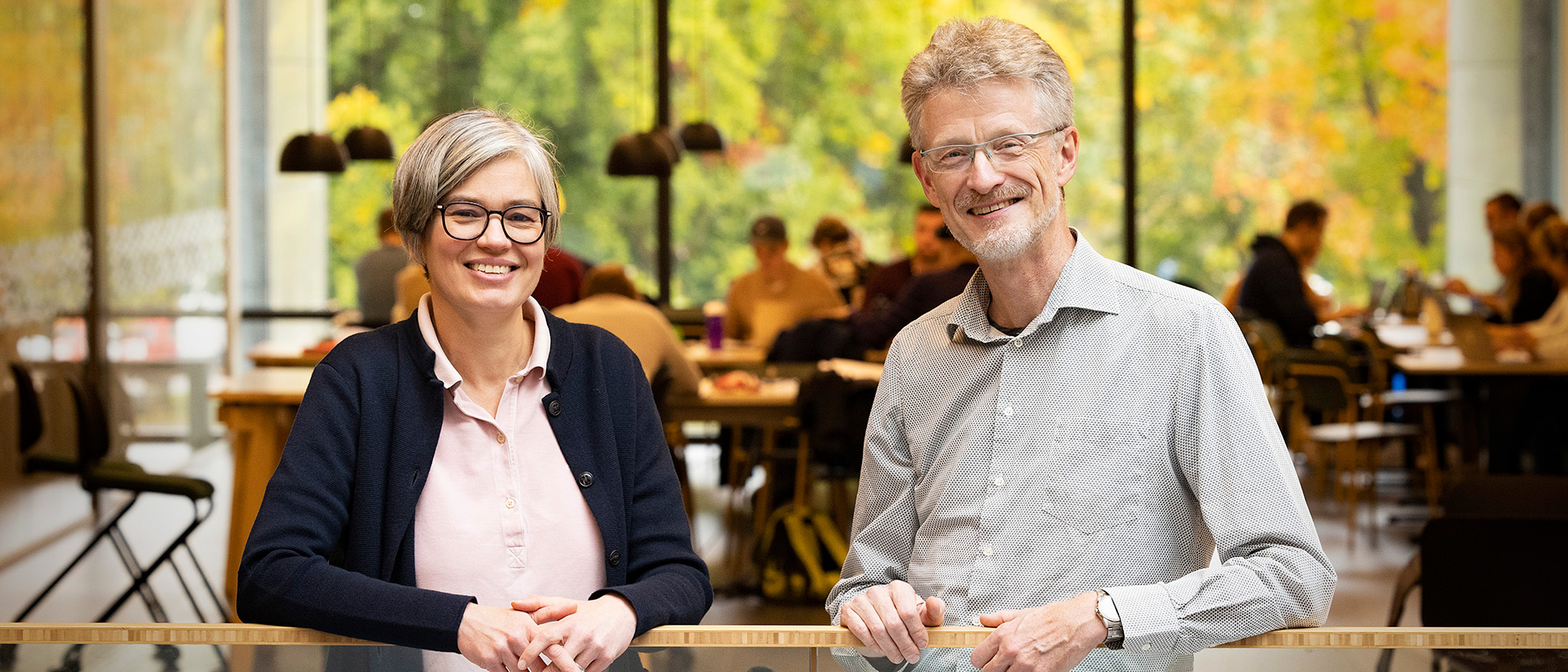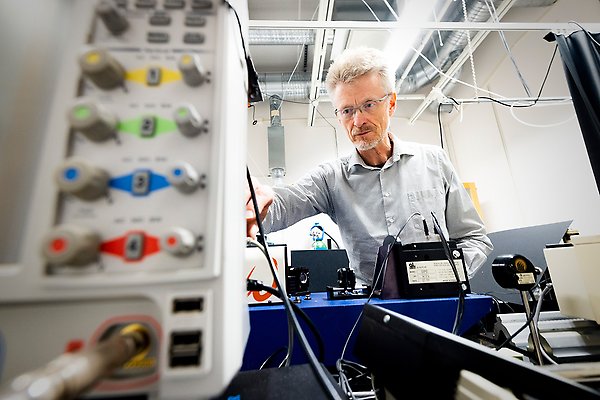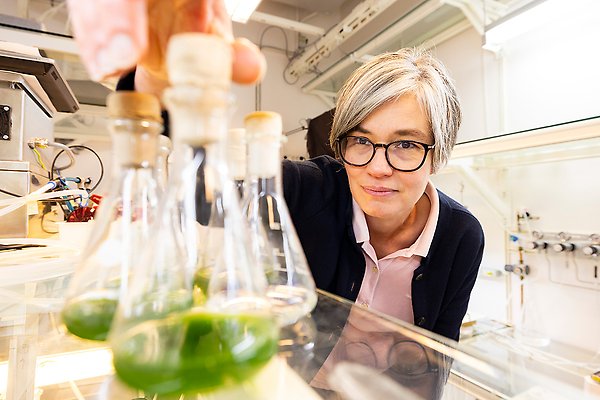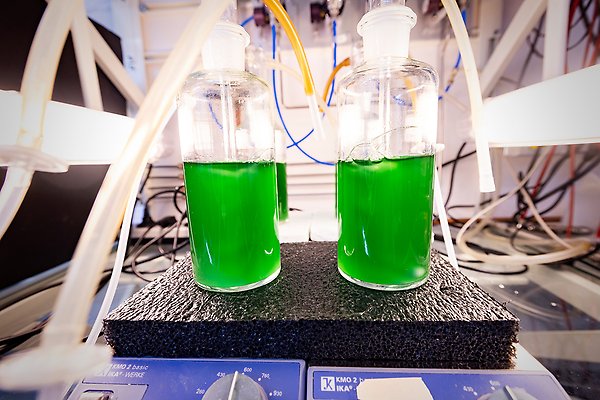Artificial photosynthesis could generate new fossil-free fuels

Pia Lindberg and Leif Hammarström are researching how we can use nature's own processes to create new carbon-neutral fuels. Photo: Mikael Wallerstedt
Sun, water and carbon dioxide interacting in artificial photosynthesis. According to researchers at Uppsala University, this could be the recipe for the fuels of tomorrow. But much research is needed before so-called solar fuels can replace fossil fuels.
Can we use nature's own processes to create new carbon-neutral fuels? Yes, according to researchers at Uppsala University, and this is also the focus of several research projects currently underway at the University.
To create so-called solar fuels, artificial photosynthesis is used, using molecules and materials that mimic the principles of green plant photosynthesis.
"Photosynthesis captures sunlight and uses its energy to drive chemical reactions that accumulate energy-rich substances like carbohydrates,” says Leif Hammarström, professor chemical physics at Ångström Laboratory, Uppsala University, where he leads a project on artificial photosynthesis.
Sun + water + carbon dioxide
Today, the vast majority of fuels such as ethanol and hydrogen are produced by fossil fuels using petroleum as a raw material. Artificial photosynthesis captures the sun's light using a technique similar to that used in solar cells, adds water and carbon dioxide, and out comes a fuel in the form of a gas or liquid, such as hydrogen or an alcohol.
"The fuels are therefore familiar, but the production of these fuels is done using renewable methods. So the big environmental benefit is that it's fossil-free," says Leif Hammarström.

The focus of artificial photosynthesis research at present is discovering more efficient processes for producing these fuels, and seeing how it can be done on a large scale. Photo: Mikael Wallerstedt
Producing fuel by artificial photosynthesis is more efficient than using natural photosynthesis. This is because it would require very large cultivated areas to achieve the same thing the natural way, areas that are mainly needed for, e.g., food production and maintaining natural ecosystems.
Efficiency and scaling up
The focus of artificial photosynthesis research at present is discovering more efficient processes for producing these fuels, and seeing how it can be done on a large scale.
“Most of our research revolves around basic science work where we try to understand first principles, and develop new catalysts and mechanisms. It's about speeding up the chemical reaction so processes become more energy efficient, simply understanding how it works and making processes better. We are working to ensure that what is not even a technology today will lay the foundations for better methods in the future," says Leif Hammarström.
Reprogrammed cyanobacteria
Others are working more on specific applications of photosynthesis for solar fuels. One of them is Pia Lindberg, senior lecturer in the Department of Chemistry at the Ångström Laboratory.

Pia Lindberg, senior lecturer in the Department ofChemistry at the Ångström Laboratory. Photo: Mikael Wallerstedt
She is involved in a project to redirect cyanobacteria to use photosynthesis to produce fuel. Normally, cyanobacteria use photosynthesis to grow, but genetic engineering has plugged new functions into their cells to produce fuels instead, for example butanol.
"The idea is to produce renewable chemicals and fuels from carbon dioxide in the atmosphere using microorganisms. Today, for example, it is possible to produce biofuels from biomass such as agricultural and forestry waste. Our idea is to use photosynthesis in a direct way in genetically modified microorganisms where we can control what the microorganism does and produces," says Pia Lindberg.
Using the organism's own process
Today, this process takes place in an indoor laboratory where the bacteria are grown in transparent bioreactors under lamplight. But in the long term, it should be possible to scale up and manage outdoor cultivation using actual sunlight.
“Today, most butanol is produced from petroleum. The small amount of biobutanol produced is not photosynthetic. The advantage of our method is that it uses carbon dioxide from the atmosphere, which means that it does not need to use sugar, but fully exploits the organism's own process.”

Normally, cyanobacteria use photosynthesis to grow, but genetic engineering has plugged new functions into their cells to produce fuels, for example butanol. Photo: Mikael Wallerstedt
Pia Lindberg estimates that a functioning product that can be blended with fossil fuels should be available within ten years.
"First, you have to improve the efficiency of the manufacturing process, which also depends on what it can cost and what the market looks like.”
The method has many potential applications. In addition to fuel, products from photosynthetic cyanobacteria could also be used as raw materials for the production of chemicals and plastics. Industries seeking to reduce their emissions could also use the method.
"Yes, if you link our process to an emission of carbon dioxide, you can capture it and reuse it.”
Anna Hedlund
Solar fuels
- Solar fuels is a generic term for fuels produced using photosynthesis. In the future, they should be able to replace fossil fuels.
- Artificial photosynthesis is a man-made photosynthesis process that mimics the natural one.
- Several research projects are now underway at Uppsala University to find efficient ways to produce different types of solar fuel.
